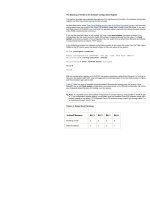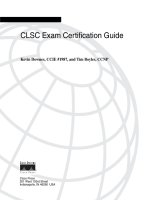Tài liệu PMP Exam Themes – the Perspective You Need To Develop To Be Prepared docx
Bạn đang xem bản rút gọn của tài liệu. Xem và tải ngay bản đầy đủ của tài liệu tại đây (108.06 KB, 7 trang )
PMP Exam Themes –
the Perspective You
Need To Develop
To Be Prepared
1-800-COURSES
www.globalknowledge.com
Expert Reference Series of White Papers
Introduction
Questions on the Project Management Professional (PMP®) exam are written from a particular perspective.
The examiners assume certain operating conditions are in place without stating those conditions.
The problem for project managers (PMs) taking the exam is that these assumptions are never clarified by the
Project Management Institute (PMI®). To make matters worse for, these assumptions must be gleaned from
the Project Management Body of Knowledge (PMBOK®).
If you know from the outset what perspective should be tak
en, studying for the exam is greatly simplified.
You
need to know how the examiners were thinking when they wrote the questions
.
Learn to Think Like the PMI
If you have extensive project experience you are likely familiar with the old adage “project management is
responsibility without authority”. Project managers become experts at getting things done without access to
the tools of authority.
However, do not let your experience override one of the underlying assumptions inherent in PMP exam ques-
tions
. As far as the PMI and its exam are concerned,
PMs should have, and therefore do have
, ultimate authori-
ty for a project. In situational exam questions, it is assumed that the PM has the authority to do the right thing
in every situation. This is a far cry from the reality that most people experience.
In order to answer situational exam questions correctly, you must learn to think “PMI”. That is, you must know
the presumptions of the examiners
.
Only then will you able to choose the best answer among the possible
choices. Do not let your personal experience override your PMI thinking.
Preparing for the PMP exam, therefore, requires both an understanding of the best practices according to PMI
and an understanding of the unwritten perspective of the examiners. These underlying assumptions are key to
success on the exam:
• Working in PM heaven—PMs hold ultimate authority
• Always be proactive
• Corrective action is the correct reaction
• Planning is king
• Update the plan regularly
• Product life cycle costing leads to best decisions
Brian Denis Egan, Global Knowledge Instructor, PMP
PMP Exam Themes – the Perspective
You Need To Develop To Be Prepared
Copyright ©2006 Global Knowledge T
raining LLC. All rights reserved. PMI, PMP
, and
PMBOK are registered trademarks of the Project Management Institute, Inc.
Page 2
•
Communication is a PM's primary tool
• Err on the side or formality
• Avoid gold plating
• PMs are stakeholder centric
• The importance of lessons learned
Working in PM Heaven – PMs Hold Ultimate Authority
Unless otherwise stated, examiners assume PMs work in an ideal project environment. It is assumed that the
project manager possesses the authority necessary to do what is right for the project.
For example, in an ideal situation, PMs would never accept a project plan given to them by others. They would
always have the time and resources to re-calculate the plan and make it their own.
In an ideal project environment, PMs are able to complete the planning process before work begins. They can
refuse to implement changes that have not been analyzed for impacts (without losing their job). In short, they
control the project with a degree of authority that is rare in the real world.
When answering exam questions, imagine a project environment the way you would like it to be. Such is the
environment PMI would like to see become the norm.
Always Be Proactive
When considering what to do in a particular situation – think proactively. Being proactive means thinking
three moves ahead.
For example, say you are the PM on a complex IT project that is centralizing customer data across the enter-
prise. The vice president of marketing calls you and says that the completion date must be moved up two
weeks to mak
e the new database available for a critical industry event.
What do you do?
Immediately ask yourself: Is this a formal change request or just a spur of the moment idea? Does this person
have the authority to force the change?
With which other stakeholders will I need to confer to assess the impact?
Proactive PMs do not just react to situations
,
they think ahead.
In the situation described above
,
proactive PMs
would treat the VP’s request as a routine, although important, change request. PMs would contract senior
team members to determine the viability and impact of the request on other constraints, such as budget and
scope. When fully informed, the PM meets with the change review board. The change review board would
determine what action to take; the PM would implement the board’s decision.
Corrective Action Is the Correct Reaction
Being proactive is also about detecting potential problems before they occur. It is the core motivation of
Monitoring and Controlling processes. We monitor project work results to ensure that they conform to the
plan. If they do not, we investigate why and implement corrective actions. When discrepancies are detected
they are investigated, not just noted in a journal.
Being proactive requires continuous observations and comparison with the plan. Any discrepancies are investigated.
Copyright ©2006 Global Knowledge T
raining LLC. All rights reserved.
Page 3
Planning Is King
A PM motto is that ”projects fail at the beginning, not at the end”. This means you must plan success into a
project. Failure to plan is planning to fail.
Planning is not an option. It is the raison d’etre of project management.
For example, say you are the PM on a new project. The sponsor is in a hurry to get going and instructs your
team members to start working on modules while you develop the project plan. What should you do?
Remember that you have the authority and responsibility to do the right thing. Therefore, you should plan
before you execute. Politely inform the sponsor that it is inappropriate for him or her to give assignments
directly to your team members. Let that person know that no work can be undertaken until there is a clear
understanding of what the project objectives are. Work may ultimately begin before there is a complete project
plan, but that work must then be planned.
Update the Plan Regularly
Project plans are living documents. There is often a huge amount of work that goes into a plan. Once complete
it is painful to even consider modifying the plan. However in the perfect project environment changes are fre-
quent, thorough,
and documented.
Every approved change request will typically result in changes to the plan within several of the knowledge
areas.
To get to PMI’
s version of project heaven you must keep the plan current and make sure you stay on top of
everything.
Product Life-Cycle Costing Leads to the Best Decisions
Pretend you are the PM of a product development project and have to mak
e a decision about safety testing. You
can save time and money on the project by avoiding child safety testing.
The product is specifically for adults
and technically does not need to be tested for children. Child safety testing has the advantage of making the
company appear to be child friendly and will reduce liability in the event of an injury involving children.
What should you do?Life-cycle costing looks at the decision in terms of the long-term interests of the organi-
zation. This may be in conflict with the short term interests of the project.
It might be cheaper and easier to avoid child safety testing for now. The project would be finished sooner. But
how would taking such a narrow view of the issues affect the long-term interests of the organization?
To make the best decision you should first consider and determine the implications of not testing, such as
increased liability, and balance this against the short-term savings.
Prudent PMs thinks long term and looks at the big picture. All PMs are expected to do the right thing for a
project,
but not at the expense of the enterprise.
Copyright ©2006 Global Knowledge T
raining LLC. All rights reserved.
Page 4
Communication Is a PM's Primary Role
PMs can expect to spend 90% of their time communicating. This includes actively monitoring what is happen-
ing with their projects and sharing that information with stakeholders.
The PM is the heart of a project. Information is the blood that must flow through the heart. If the heart stops
beating, then information stops circulating and the project body withers.
In a PMI-ideal project environment PMs have the staff necessary to complete the work. They themselves do
not act as a resource or spend their time updating records. Someone else updates the plan and collates
reports. The PMs manage. This does not include correcting code, working with the troops to speed things up, or
filling in for someone who is sick.
In the PMI examiners’ view, PMs are accountable for ensuring the project gets done and done right; they are
not the ones actually doing the work. PMs watch, listen, and direct – they manage resources. They are not
expected to ‘do’. The act of doing takes them away from the art of managing and monitoring.
Err on the Side of Formality
The PMP examiners will expect you to answer questions as though you conduct your job with utmost formali-
ty. Formality includes paper trails and obtaining signatures. For example, say the CEO calls you up and
demands a change. You should then respond by e-mailing a change request form, because without a complet-
ed and signed form, no action should be taken.
PMI’s project management systems are very detailed: there is a management plan for everything; there is a
document or log to record everything;
every decision is a written decision signed by the authorizing person;
and nothing is done casually.
Formality also means preparing an audit trail. Every decision,
every action, every choice implies an expenditure
of time and money
. Therefore, every expenditure needs a justification and authorization.
The PM is responsible
for making sure that these justifications and authorizations are archived.
Avoid Gold Plating
Gold plating in this instance means overshooting on the scope of a project.
It is usually done with the best of
intentions. Team members working on a project believe they are ‘adding value’ to a project by going beyond
the requirements.
Gold plating is a remnant of the past when the motto of project management was to “meet or exceed cus-
tomers expectations”.
T
his motto suggested that overshooting expectations w
as a good thing.
But overshooting is not a good thing anymore. Experience has shown that adding extras will always take more
time to accomplish, and time means money. Changes are almost guaranteed to take more time and money, yet
they are not guaranteed to increase customer satisfaction. It makes more sense to concentrate on delivering
the project on time, within budget, and within scope.
If there is a surplus of time and money at the end of a project let the customer decide how they would like the
surplus consumed,
if at all.
Copyright ©2006 Global Knowledge T
raining LLC. All rights reserved.
Page 5









